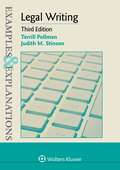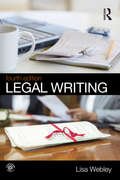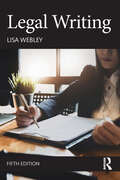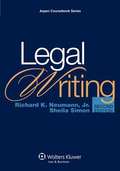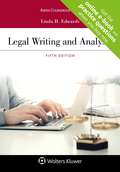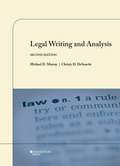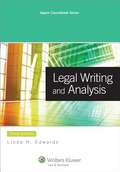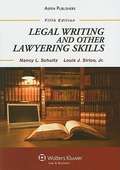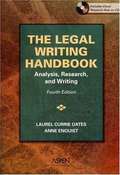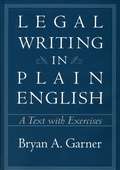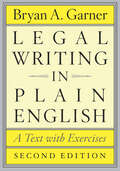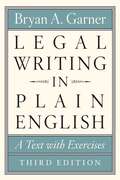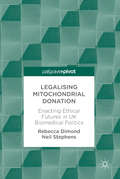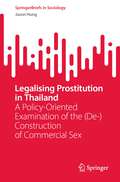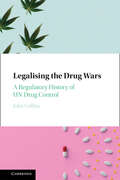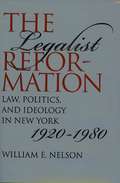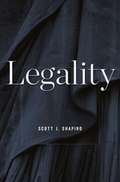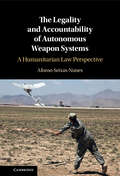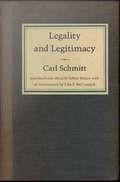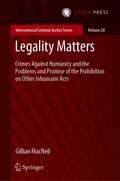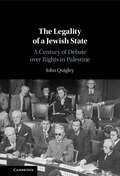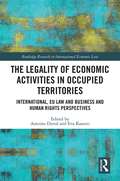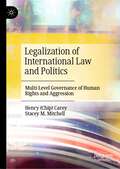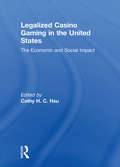- Table View
- List View
Legal Writing (Examples and Explanations)
by Terrill Pollman; Judith M. StinsonA favorite classroom prep tool of successful students that is often recommended by professors, the Examples & Explanations (E&E) series provides an alternative perspective to help you understand your casebook and in-class lectures. Each E&E offers hypothetical questions complemented by detailed explanations that allow you to test your knowledge of the topics in your courses and compare your own analysis.
Legal Writing
by Lisa WebleyLegal Writing guides students comprehensively through this vital legal skill and addresses a range of assessment methods from exam questions to final essays and problem answers. It considers how to deconstruct essay and problem questions and how to conduct and apply legal research to answer set questions. Lisa Webley explains how to reference others' work clearly and correctly, making this book a useful tool for students concerned about issues of plagiarism. It also focuses on how to develop critical thinking and communicate legal arguments, with both good and bad examples of written work considered and discussed in the text. Legal Writing is particularly useful for undergraduate students, especially at the beginning of degree studies, and for GDL and CPE students too. This fully revised fourth edition includes: Guidance on the avoidance of plagiarism including examples of poor practice and best practice. Worked examples throughout the text, including guidance on deciphering essay questions in exams and coursework, along with additional examples from across the legal curriculum on the companion website. An improved companion website with increased guidance for revision to allow students to test their progress and further engage with the topics in the book. Clearly written and easy to use, Legal Writing enables students to fully engage with essay and exam writing as a vital foundation to their undergraduate degree.
Legal Writing
by Lisa WebleyLegal Writing guides students comprehensively through this vital legal skill and addresses a range of assessment methods from exam questions to final essays and problem answers. It considers how to deconstruct essay and problem questions and how to conduct and apply legal research to answer set questions. Lisa Webley explains how to reference others’ work clearly and correctly, making this book a useful tool for students concerned about issues of plagiarism. Legal Writing also focuses on how to develop critical thinking and communicate legal arguments, with both good and bad examples of written work considered and discussed in the text. Legal Writing is particularly useful for undergraduate students, especially at the beginning of degree studies, as well as for those preparing for the SQE exams. This fully revised fifth edition includes: Guidance on how to avoid plagiarism, including examples of the best and worst practices Worked examples throughout the text, including how to decipher essay questions in exams and coursework An expanded set of accompanying digital learning resources with increased guidance for revision to allow students to test their progress and further engage with the topics in the book. Clearly written and easy to use, Legal Writing enables students to fully engage with essay and exam writing as a vital foundation to their undergraduate degree.
Legal Writing (2nd Edition)
by Sheila J. Simon Richard K. Neumann Jr.Written for law students, this well-organized and thorough book shows how to hone legal writing skills in real-world situations. Topics include process, style, memoranda writing, organizing analysis (CREAC), analytical writing, persuasive writing, telling a client's story, making the client's argument, appellate briefs, and oral argument. Each chapter includes exercises. Appendices contain sample memos and briefs. An accompanying access code protected website offers supplementary material including videos, checklists, and articles. Annotation ©2011 Book News, Inc. , Portland, OR (booknews. com)
Legal Writing And Analysis (Aspen Coursebook)
by Linda Holdeman EdwardsThis streamlined text offers a straightforward guide to developing legal writing and analysis skills for beginning legal writers. Legal Writing and Analysis, Fifth Edition by Linda Edwards, leads students logically through reading and analyzing the law, writing the discussion of a legal question, and writing office memos, letters, and briefs. The text includes chapters on citation form, writing style, professionalism, and oral argument. <P><P> The book features special focus on forms of legal reasoning (rules, analogies, policies, principles, customs, inferences, and narrative) complete with examples and exercises. It teaches students to recognize rule structures and use them to organize their document. <P><P> New to the Fifth Edition: Streamlined chapters and exercises Updated citation materials covering current editions of both citation manuals Product page featuring more material on professional letters and accessible coverage and use of legal theory <P><P>Professors and students will benefit from: Contextual learning, including important legal method material Superior treatment of how to organize a legal discussion Clear, ample coverage of legal reasoning Practice-oriented approach Numerous examples and short exercises for formative assessment Strong coverage of professional responsibility
Legal Writing and Analysis (Coursebook Ser.)
by Michael Murray Christy DeSanctisThis law school text teaches the fundamentals of legal writing, analysis, and the American legal method. It fosters critical lawyering skills, such as how to identify a legal rule from a variety of sources, analyze and explain its components, apply the rule to answer a problem, and communicate the results in an effective manner. In the second edition, coverage of authority and rule formation have been streamlined and tightened. The authors have increased the visual appeal and content of callout boxes, charts, and tables; and they have replaced and shortened the length of examples so as to provide two to three times as many samples of practitioner writing in each chapter. With this new edition, the authors endeavor to train future lawyers to be ethical and professional issue-spotters, analysts, counselors, problem-solvers, and communicators working to advance their clients’ interests.
Legal Writing and Analysis (Third Edition)
by Linda H. EdwardsIdeal for beginning legal writers, this logically organized and exceptionally well-written text offers a concise and straightforward guide to legal writing and analysis. Updated to include exercises with increased focus on first-year courses, Legal Writing and Analysis, Second Edition, starts with an overview of the legal system and the lawyer¿s role, then leads students from reading and analyzing the law through the process of legal writing, providing numerous examples and exercises along the way. Classroom-tested features of this bestselling text include: a consistent use of the legal method approach, from an opening chapter providing an overview of a civil case and the lawyer¿s role, to information about the legal system, case briefing, synthesizing cases, and statutory interpretation an emphasis on analogical reasoning and synthesizing cases, as well as rule-based and policy-based reasoning, with explanations of how to use these types of reasoning to organize a legal discussion a logical organization that starts with reading and analyzing the law and then moves on to writing the discussion of a legal question, writing an office memo and professional letters, and advocacy writing. chapters addressing style and formality considerations as well as oral advocacy effective coverage of the use of precedent a superior discussion of small-scale organization, including the thesis paragraph numerous examples and frequent short exercises that encourage students to apply concepts a comprehensive Teacher¿s Manual that offers helpful advice for instructors. The Second Edition offers new exercises, including increased focus on first-year courses. a revision of Part Five on advocacy writing, streamlining the order of the chapters and adding more coverage of questions presented an updated citation chapter. Chapter 12 on the Office Memorandum has been expanded to add another format for a question presented and is accompanied by an example
Legal Writing And Other Lawyering Skills, 5e
by Nancy L. Schultz Louis J. Sirico Jr.With a consistent emphasis on precision and good organization, Legal Writing and Other Lawyering Skills, Fifth Edition, shows students how tod raft memoranda, opinion letters, pleadings, briefs, and other legal documents. But because communication in the practice of law occurs in specificcontexts, authors Nancy L. Schultz and Louis J. Sirico, Jr . teach other valuable lawyering skills, such as client counseling, negotiating,and how to present an oral argument before the court, in this timely andstudent-friendly text. Now with a more contemporary look that reflects a new publisher and revisions requested by users of the text, the Fifth Edition of Legal Writing and Other Lawyering Skills features: a straightforward and student-friendly approach, framed and supported by a logical organization, streamlined coverage that focuses on basic communication skills in practice, complete coverage of legal writing--with outstanding chapters on writing style and how to write a memo, in-depth instruction on legal analysis, oral argument, and how to write an appellate brief, a helpful preliminary overview of the American legal system, refreshed, updated, and carefully honed practice exercises, expanded coverage of electronic research, new coverage of electronic communication, format, etiquette, ethics, and liability, thoroughly up-to-date court citations, cases, and sample documents, generous use of sample documents within the text and in the Appendices. The focused exercises and examples in Legal Writing and Other Lawyering Skills, Fifth Edition, simulate the tasks performed by lawyers in practice and reflect the authors' forward-looking, practice-based approach to teaching writing and lawyering skills to law students.
The Legal Writing Handbook: Analysis, Research, and Writing
by Laurel Currie Oates Anne EnquistStudents and professors will welcome this new edition of the only text for legal writing and research that covers all three key components of the first-year course -- research, writing, and analysis.
Legal Writing in Plain English: A Text with Exercises
by Bryan A. GarnerAdmirably clear, concise, down-to-earth, and powerful-- unfortunately, these adjectives rarely describe legal writing, whether in the form of briefs, opinions, contracts, or statutes. In Legal Writing in Plain English, Bryan A. Garner provides lawyers, judges, paralegals, law students, and legal scholars sound advice and practical tools for improving their written work. The book encourages legal writers to challenge conventions and offers valuable insights into the writing process: how to organize ideas, create and refine prose, and improve editing skills. In essence, it teaches straight thinking-- a skill inseparable from good writing. Replete with common sense and wit, the book draws on real-life writing samples that Garner has gathered through more than a decade of teaching in the field. Trenchant advice covers all types of legal materials, from analytical and persuasive writing to legal drafting. Meanwhile, Garner explores important aspects of document design. Basic, intermediate, and advanced exercises in each section reinforce the book's principles. (An answer key to basic exercises is included in the book; answers to intermediate and advanced exercises are provided in a separate Instructor's Manual, free of charge to instructors.) Appendixes include a comprehensive punctuation guide with advice and examples, and four model documents. Today more than ever before, legal professionals cannot afford to ignore the trend toward clear language shorn of jargon. Clients demand it, and courts reward it. Despite the age-old tradition of poor writing in law, Legal Writing in Plain English shows how legal writers can unshackle themselves. Legal Writing in Plain English includes: *Tips on generating thoughts, organizing them, and creating outlines. *Sound advice on expressing your ideas clearly and powerfully. *Dozens of real-life writing examples to illustrate writing problems and solutions. *Exercises to reinforce principles of good writing (also available on the Internet). *Helpful guidance on page layout. *A punctuation guide that shows the correct uses of every punctuation mark. *Model legal documents that demonstrate the power of plain English.
Legal Writing in Plain English: A Text with Exercises (Chicago Guides to Writing, Editing, and Publishing)
by Bryan A. GarnerAdmirably clear, concise, down-to-earth, and powerful--all too often, legal writing embodies none of these qualities. Its reputation for obscurity and needless legalese is widespread. Since 2001 Bryan A. Garner's Legal Writing in Plain English has helped address this problem by providing lawyers, judges, paralegals, law students, and legal scholars with sound advice and practical tools for improving their written work. Now the leading guide to clear writing in the field, this indispensable volume encourages legal writers to challenge conventions and offers valuable insights into the writing process that will appeal to other professionals: how to organize ideas, create and refine prose, and improve editing skills. Accessible and witty, Legal Writing in Plain English draws on real-life writing samples that Garner has gathered through decades of teaching experience. Trenchant advice covers all types of legal materials, from analytical and persuasive writing to legal drafting, and the book's principles are reinforced by sets of basic, intermediate, and advanced exercises in each section. In this new edition, Garner preserves the successful structure of the original while adjusting the content to make it even more classroom-friendly. He includes case examples from the past decade and addresses the widespread use of legal documents in electronic formats. His book remains the standard guide for producing the jargon-free language that clients demand and courts reward.
Legal Writing in Plain English, Third Edition: A Text with Exercises (Chicago Guides to Writing, Editing, and Publishing)
by Bryan A. GarnerThe leading guide to clear writing—and clear thinking—in the legal profession for more than two decades, now newly updated. Admirably clear, concise, down-to-earth, and powerful—all too often, legal writing embodies none of these qualities. Its reputation for obscurity and needless legalese is widespread. Since 2001, Bryan A. Garner’s Legal Writing in Plain English has helped address this problem by providing lawyers, judges, paralegals, law students, and legal scholars with sound advice and practical tools for improving their written work. Now the leading guide to clear writing in the field, this indispensable volume encourages legal writers to challenge conventions and offers valuable insights into the writing process: how to organize ideas, create and refine prose, and improve editing skills. Accessible and witty, Legal Writing in Plain English draws on real-life writing samples that Garner has gathered through decades of teaching experience. Trenchant advice covers all types of legal materials, from analytical and persuasive writing to legal drafting, and the book’s principles are reinforced by sets of basic, intermediate, and advanced exercises in each section. For this third edition, Garner has retained the structure of the previous versions, with updates and new material throughout. There are new sections on making your writing vivid and concrete and on using graphics to enhance your argument. The coverage and examples of key topics such as achieving parallelism, avoiding legalese, writing effective openers and summaries, and weaving quotations into your text have also been expanded. And the sample legal documents and exercises have been updated, while newly added checklists provide quick summaries of each section. Altogether, this new edition will be the most useful yet for legal professionals and students seeking to improve their prose.
Legalising Mitochondrial Donation: Enacting Ethical Futures In Uk Biomedical Politics
by Rebecca Dimond Neil StephensIn 2015 the UK became the first country in the world to legalise mitochondrial donation, a controversial germ line reproductive technology to prevent the transmission of mitochondrial disease. Dimond and Stephens track the intense period of scientific and ethical review, public consultation and parliamentary debates preceeding the decision. They draw on stakeholder accounts and public documents to explore how patients, professionals, institutions and publics mobilised within ‘for’ and ‘against’ clusters, engaging in extensive promissory, emotional, bureaucratic, ethical, embodied and clinical labour to justify competing visions of an ethical future. They describe how this decision is the latest iteration of a UK sociotechnical imaginary in which the further liberalization of human embryo research and use is rendered legitimate and ethical through modes of consultation and permissive but strictly regulated licensing. Overall, this book presents a timely, multi-dimensional, and sociological account of a globally significant landmark in the history of human genetics, and will be relevant to those with an interest in genetics, Science, Technology and Society, the sociology of medicine, reproductive technology, and public policy debate.
Legalising Prostitution in Thailand: A Policy-Oriented Examination of the (De-)Construction of Commercial Sex (SpringerBriefs in Sociology)
by Jason HungThis book problematises the socioeconomic and institutional construction of prostitution in Thai contexts, identifying the root causes that propel underprivileged, discriminated and deprived women and girls to enter the sex industry. The author considers Thailand’s tolerance of prostitution and sex trafficking, despite criminalising prostitution since 1960. In doing so, they explain how criminalising prostitution does not lower the odds of women and girls engaging in commercial sex, but rather, legally marginalises them from receiving the necessary social and healthcare support. The book highlights that neither can Thailand pragmatically practice a zero-tolerance stance against prostitution - primarily due to severe police corruption and its heavy reliance on the sex tourism economy to support the national economic growth - nor is Thailand willing to fully crack down on the domestic sex industry. Engaging in an evaluation of how legalising and decriminalising prostitution, along with continuing to implement policies and interventions that alleviate the root causes of prostitution, can help Thailand build a more inclusive society and less-prostitution-reliant economy in the long term, the book provides a nuanced understanding of the relationships between society, inequality, governance, criminality, and policy in Southeast Asian contexts. It is relevant to students and researchers in sociology, socio-criminology, public policy, government and Southeast Asian studies.
Legalising the Drug Wars: A Regulatory History of UN Drug Control
by John CollinsWhere did the regulatory underpinnings for the global drug wars come from? This book is the first fully-focused history of the 1961 UN Single Convention on Narcotic Drugs, the bedrock of the modern multilateral drug control system and the focal point of global drug regulations and prohibitions. Although far from the propagator of the drug wars, the UN enabled the creation of a uniform global legal framework to effectively legalise, or regulate, their pursuit. This book thereby answers the question of where the international legal framework for drug control came from, what state interests informed its development and how complex diplomatic negotiations resulted in the current regulatory system, binding states into an element of global policy uniformity.
The Legalist Reformation
by William E. NelsonBased on a detailed examination of New York case law, this pathbreaking book shows how law, politics, and ideology in the state changed in tandem between 1920 and 1980. Early twentieth-century New York was the scene of intense struggle between white, Anglo-Saxon, Protestant upper and middle classes located primarily in the upstate region and the impoverished, mainly Jewish and Roman Catholic, immigrant underclass centered in New York City. Beginning in the 1920s, however, judges such as Benjamin N. Cardozo, Henry J. Friendly, Learned Hand, and Harlan Fiske Stone used law to facilitate the entry of the underclass into the economic and social mainstream and to promote tolerance among all New Yorkers.Ultimately, says William Nelson, a new legal ideology was created. By the late 1930s, New Yorkers had begun to reconceptualize social conflict not along class lines but in terms of the power of majorities and the rights of minorities. In the process, they constructed a new approach to law and politics. Though doctrinal change began to slow by the 1960s, the main ambitions of the legalist reformation--liberty, equality, human dignity, and entrepreneurial opportunity--remain the aspirations of nearly all Americans, and of much of the rest of the world, today. "This splendid book . . . sets a new and very high standard for studies of American legal history in the twentieth century.--American Historical Review"Drawing on a beautifully detailed study of thousands of court opinions and life in New York, William Nelson reveals how twentieth century common law jurists brought together the diverse racial, ethnic, and religious factions in the state.--Harvard Law Review"Nelson's vision is expansive, his research prodigious, his analysis insightful, and his achievement impressive. . . . This fresh research is scholarship of the first order, in itself a major contribution.--Journal of American History"Nowhere is the concept of the law as an evolving, dynamic, and progressive force in modern American society better espoused than in this seminal, exhaustive piece of legal and historical research.--Library JournalBased on a detailed examination of New York case law, The Legalist Reformation traces the efforts of citizens of diverse racial, ethnic, and religious backgrounds to live together in the state during the past century. William Nelson argues that the most powerful instrument facilitating these efforts has been the law of New York--law proclaimed largely by judges such as Benjamin N. Cardozo, Henry J. Friendly, and Learned Hand rather than by legislators or federal officials. Furthermore, the legal ideology outlined by New York jurists has become a standard for justice worldwide among diverse cultures whose people, like New Yorkers, are striving to coexist. -->
Legality
by Scott J. ShapiroWhat is law? In this book, Scott Shapiro draws on current work in the theory of action to offer an original and compelling answer to this perennial philosophical question.
The Legality and Accountability of Autonomous Weapon Systems: A Humanitarian Law Perspective
by Afonso Seixas-NunesBy adopting a multi-disciplinary approach, this book provides a comprehensive analysis of the legality of the use of autonomous weapons systems under international law. It examines different arguments presented by States, roboticists and scholars to demonstrate the challenges such systems will create for the laws of war. This study examines how technology of warfare seeks to increase the dissociation of risk and communication between weapons and their human operators. Furthermore, it explains how algorithms might give rise to 'errors' on the battlefield that cannot be directly attributed to human operators. Against this backdrop, Dr Seixas-Nunes examines three distinct legal frameworks: the distinction between the legality of weapons and the laws of targeting; different mechanisms of individual accountability and the importance of recovering the category of 'dolus eventualis' for programmers and technicians and, finally, State responsibility for violations of the laws of war caused by weapons' software errors.
Legality And Legitimacy
by Carl SchmittCarl Schmitt ranks among the most original and controversial political thinkers of the twentieth century. His incisive criticisms of Enlightenment political thought and liberal political practice remain as shocking and significant today as when they first appeared in Weimar Germany. Unavailable in English until now, Legality and Legitimacy was composed in 1932, in the midst of the crisis that would lead to the collapse of the Weimar Republic and only a matter of months before Schmitt's collaboration with the Nazis. In this important work, Schmitt questions the political viability of liberal constitutionalism, parliamentary government, and the rule of law. Liberal governments, he argues, cannot respond effectively to challenges by radical groups like the Nazis or Communists. Only a presidential regime subject to few, if any, practical limitations can ensure domestic security in a highly pluralistic society. Legality and Legitimacy is sure to provide a compelling reference point in contemporary debates over the challenges facing constitutional democracies today. In addition to Jeffrey Seitzer's translation of the 1932 text itself, this volume contains his translation of Schmitt's 1958 commentary on the work, extensive explanatory notes, and an appendix including selected articles of the Weimar constitution. John P. McCormick's introduction places Legality and Legitimacy in its historical context, clarifies some of the intricacies of the argument, and ultimately contests Schmitt's claims regarding the inherent weakness of parliamentarism, constitutionalism, and the rule of law.
Legality Matters: Crimes Against Humanity and the Problems and Promise of the Prohibition on Other Inhumane Acts (International Criminal Justice Series #28)
by Gillian MacNeilThis book examines the way international criminal courts and tribunals have interpreted the crimes against humanity proscription of other inhumane acts. This clause is consistently used in spite of the long list of more specific offences forbidden as crimes against humanity. The volume proposes that the current approach is based on a misunderstanding of the nature of the clause. Properly understood, the clause is an invitation to courts to create and apply retroactive criminal laws. This leads to a problem. A prohibition on the use of retroactive criminal laws, one which admits no exceptions, is deeply embedded in international law. The author argues that it is time to revisit the assumption that retroactive criminal laws can never be deployed in a fair legal system. Drawing lessons from an exploration on the way the prohibition on retroactive laws is applied in practice, she proposes a new framework for understanding the clause proscribing the commission of other inhumane acts. This book will be of relevance to anyone interested in international criminal law or criminal law theory. Gillian MacNeil is Assistant Professor at Robson Hall, the Faculty of Law of the University of Manitoba in Winnipeg, Canada.
The Legality of a Jewish State: A Century of Debate over Rights in Palestine
by John QuigleyIn The Legality of a Jewish State, the author traces the diplomatic history that led to the partition of Palestine in 1948 and the creation of Israel as a state. He argues that the fate of Palestine was not determined on the basis of principle, but by the failure of legality. In focusing on the lawyer-diplomats who pressed for and against a Jewish state at the United Nations, he offers an explanation of the effort in 1947-48 by Arab states at the UN to gain a legal opinion from the International Court of Justice about partition and the declaration of a Jewish state. Their arguments at that time may surprise a twenty-first-century reader, touching on issues that are still at the heart of the contemporary conflict in the Middle East.
The Legality of Boxing: A Punch Drunk Love? (Birkbeck Law Press)
by Jack AndersonThe first book of its kind dedicated to an assessment of the legality of boxing, The Legality of Boxing: A Punch Drunk Love? assesses the legal response to prize fighting and undertakes a current analysis of the status of boxing in both criminal legal theory and practice. In this book, Anderson exposes boxing’s 'exemption' from contemporary legal and social norms. Reviewing all aspects of boxing - historical, legal, moral, ethical, philosophical, medical, racial and regulatory - he concludes that the supposition that boxing has a (consensual) immunity from the ordinary law of violence, based primarily on its social utility as a recognised sport, is not as robust as is usually assumed. It: suggests that the sport is extremely vulnerable to prosecution and might in fact already be illegal under English criminal law outlines the physical and financial exploitation suffered by individual boxers both inside and outside the ring, suggesting that standard boxing contracts are coercive thus illegal and that boxers do not give adequate levels of informed consent to participate advocates a number of fundamental reforms, including possibly that the sport will have to consider banning blows to the head proposes the creation of a national boxing commission in the US and a similar entity in the United Kingdom, which together would attempt to restore the credibility of a sport long know as the red-light district of sports administration. An excellent book, it is a must read for all those studying sports law, popular culture and the law and jurisprudence.
The Legality of Economic Activities in Occupied Territories: International, EU Law and Business and Human Rights Perspectives (Routledge Research in International Economic Law)
by Antoine Duval Eva KassotiThis edited volume explores the question of the lawfulness under international law of economic activities in occupied territories from the perspectives of international law, EU law, and business and human rights. Providing a multi-level overview of relevant practices, policies and cases, the book is divided in three parts, each dealing with how different legal fields have come to grips with the challenges brought about by the question of the lawfulness under international law of economic activities in occupied territories. The first part includes contributions pertaining to the international law dimension of the question. It contains chapters on the conjunction between jus in bello, jus ad bellum and international human rights law in the context of exploitation of natural resources in territories under belligerent occupation; on third party obligations flowing from the application of occupation law in relation to natural resources exploitation; and on State practice with regards to trading with occupied territories. The second part focuses on EU law and contains contributions that assess the EU’s approach to occupied territories and the extent to which this approach comports with the EU’s obligations under international law; contributions providing an in-depth assessment of the case-law of the CJEU on occupied territories; as well as contributions pertaining to the political considerations that may influence the legal framing of questions pertaining to occupied territories. The final part focuses on the business and human rights perspective, with chapters on investment arbitration as a means for holding the occupant accountable for its conduct towards foreign investments and investors; on the role and impact of the soft law framework governing corporate activity (such as the UN Guiding Principles) on business involvement with occupied territories; as well as a final case study on the dispute involving Israeli football activity in settlements located in the OPT and the legal responsibility of FIFA in this regard. The book will appeal to academics, practitioners and policy-makers alike.
Legalization of International Law and Politics: Multi-Level Governance of Human Rights and Aggression
by Henry (Chip) Carey Stacey M. MitchellThis book provides an expanded conceptualization of legalization that focuses on implementation of obligation, precision, and delegation at the international and domestic levels of politics. By adding domestic politics and the actors to the international level of analysis, the authors add the insights of Kenneth Waltz, Graham Allison, and Louis Henkin to understand why most international law is developed and observed most of the time. However, the authors argue that law-breaking and law-distorting occurs as a part of negative legalization. Consequently, the book offers a framework for understanding how international law both produces and undermines order and justice. The authors also draw from realist, liberal, constructivist, cosmopolitan and critical theories to analyse how legalization can both build and/or undermine consensus, which results in either positive or negative legalization of international law. The authors argue that legalization is a process over time and not just a snapshot in time.
Legalized Casino Gaming in the United States: The Economic and Social Impact
by Cathy Hc HsuCovering the entire United States gaming market, Legalized Casino Gaming in the United States provides gaming researchers, policymakers, and hospitality students comprehensive overview of the history, development, legislation, and economic and social impacts of riverboat, land-based, and Native American casino gaming. Containing national and regional research about the industry, this book will provide students with a historical view on gaming and the hospitality industry, offer researchers data and current market status of the industry; and will give policymakers information about the advantages and disadvantages of a gaming industry in their community.Comprehensive and thorough, Legalized Casino Gaming in the United States is full of case studies, data, and surveys that provide you with credible information on community incomes, residents’attitudes about gaming, and gaming taxes in certain states. This fact-filled book will help you evaluate and learn about the pros and cons of the industry, including: reviewing changes in the gaming laws and regulations in particular regions and segments of the industry explaining laws and regulations by state for riverboat and other Native American land-based gaming examining negative and positive social impacts of gaming, including crime; quality of life; community services; availability of entertainment, recreation, and cultural activities; community attractiveness, such as reputation, appearance, cleanliness, and traffic; local resident attitudes; and pathological gaming explaining Nevada’s gaming regulatory system, including the roles of the Nevada Gaming Commission and Gaming Control Board, and discussing issues related to currency transactions, exclusion lists, work permits, customer disputes, and underage gambling discussing positive economic aspects of Native American gaming, such as tax benefits, in Connecticut, Wisconsin, Oregon, and Minnesota, and how the industry impacts surrounding communitiesExamining the industry from ethical, economic, and social standpoints, the contributors offer you several perspectives of a situation, not just one side of an issue, to help you make educated decisions or opinions about gaming. Bolstered with charts, graphs, tables, and future research recommendations, Legalized Casino Gaming in the United States offers you an in-depth and comprehensive look at the gaming industry, helping you weigh the positive and negative effects of one of the most popular areas of hospitality.
